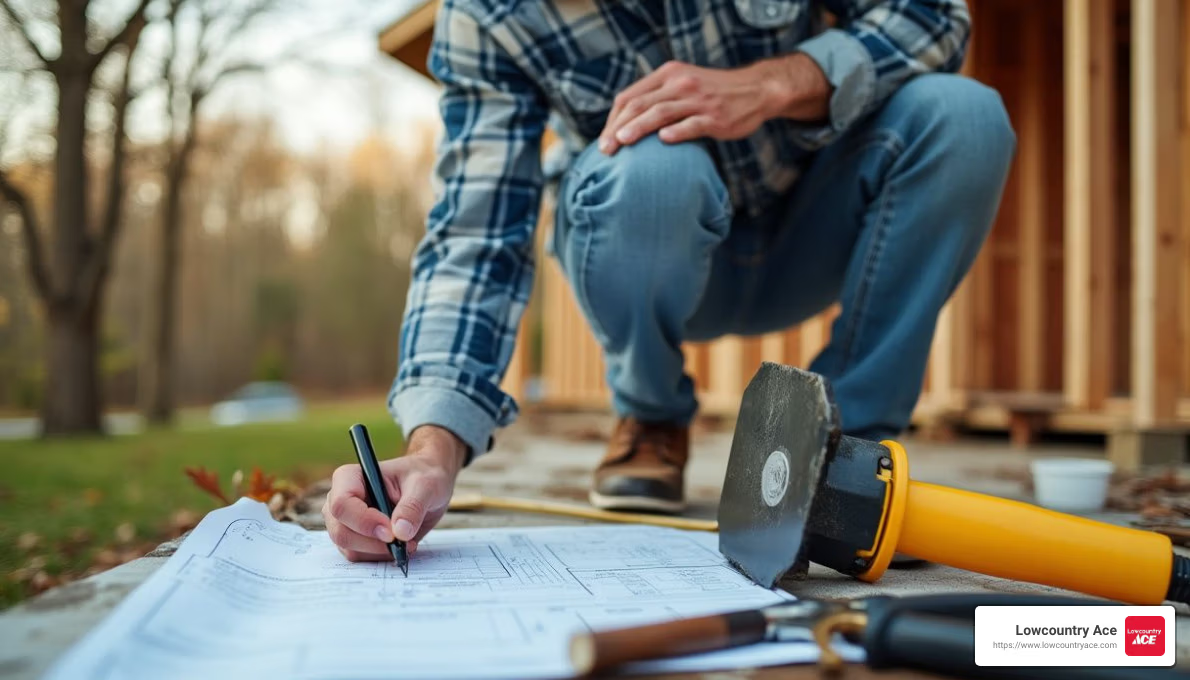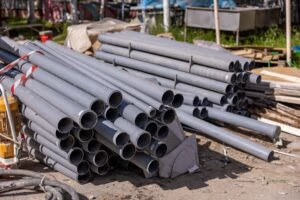Planning Your DIY Home Addition
Thinking about a diy home addition to your living space? Whether you need more room for a growing family or just want a new hobby area, adding onto your home yourself can be a satisfying and cost-effective solution. Here are some key points to consider right away:
- Budget Carefully: Determine your overall budget, including unexpected costs.
- Plan Ahead: Create a detailed plan or blueprint and follow local building codes.
- Consult Pros: Even as a DIY enthusiast, get advice from contractors or architects.
- Get Permits: Ensure you have all the necessary permits before you start.
- Safety First: Follow safety precautions, especially around utilities and structural changes.
Before you begin, it’s crucial to understand your limits. Most homeowners can manage some parts of the project, like painting or minor carpentry. But complex tasks like electrical work or major structural changes should always involve a pro.
The helpful team at Lowcountry Ace can guide you through the planning phase, ensuring you have the right tools and materials. With years of experience, they offer invaluable advice to help you complete your DIY home addition successfully.
Ready to dive into the nitty-gritty of this exciting project? Let’s get started with the basics.
Can I Do It on My Own?
When considering a DIY home addition, it’s essential to know your limitations. Yes, you can handle many aspects of the project yourself, but some tasks should be left to the professionals. Here’s a breakdown to help you decide.
Know Your Limitations
Experience Matters: If you’re not a seasoned contractor, taking on a full home addition solo can be daunting. Mistakes can be costly and time-consuming. For example, misjudging the structural integrity or using improper materials can lead to significant issues down the line.
Cost Considerations: While DIY can save money, errors can increase costs. Ignoring codes, using wrong materials, or mishandling utilities can result in hefty fines or repair costs. Hiring a professional for critical tasks can be more economical in the long run.
Hiring a Contractor
Design Assistance: Start by consulting a contractor or an architect to help design the expansion. They can create a detailed plan and ensure it complies with local building codes. This step is crucial to avoid legal and structural issues.
Permits: Submit your design plan to your city’s building and zoning department for approval. Collect all necessary permits, like electrical, plumbing, and gas permits. Display these permits prominently while working on the project.
Step-by-Step Guidance
Even if you decide to DIY, getting some professional help can make a big difference. Here’s a suggested approach:
-
Consult Professionals: Hire a contractor for tasks like foundation work and framing. For example, a homeowner shared that they paid their contractor to build the basement and frame the addition. They managed other tasks like electrical work and drywall themselves.
-
Rent Equipment: For excavation and heavy lifting, consider renting equipment. This can save time and reduce physical strain.
-
Safety First: Always call 811 before digging to avoid hitting utility lines. This free service will mark underground utilities, ensuring you dig safely.
Costs and Savings
Budget Wisely: Creating a realistic budget is vital. Include costs for tools, materials, permits, and professional help. Add a 10%-20% buffer for unexpected expenses.
DIY vs. Professional Help: You can save money by doing simpler tasks yourself, like painting or installing flooring. Leave complex tasks like electrical, plumbing, and HVAC installations to professionals. This approach balances cost savings with safety and quality.
Example: A homeowner shared their experience of spending 2.5 years building an addition. They made 468 trips to hardware stores, highlighting the time and effort involved. Despite the challenges, they saved money by doing some of the work themselves.
In the next section, we’ll dive into the Step-by-Step Guide to a DIY Home Addition, covering planning, permits, excavation, framing, roofing, utilities, and finishes.
Step-by-Step Guide to a DIY Home Addition
Planning and Design
Start with a Solid Plan: Before you lift a hammer, consult a contractor or architect to help design your home addition. They can help you create a detailed design plan that includes specifications and ensures compliance with local building codes. This step is crucial to avoid legal issues and structural mishaps.
Submit Your Plans: Once your design is ready, submit it to your city’s building and zoning department for approval. You’ll need to collect all necessary permits, such as electrical, plumbing, and gas. Display these permits prominently while you work.
Excavation and Foundation
Call Before You Dig: Before you start digging, call 811, the national “call before you dig” hotline. They will notify utility companies to mark where underground cables, electric lines, water, or gas lines are located on your property. This step is critical for safety and to avoid costly repairs.
Rent Equipment: For excavation, you might need to rent equipment like a mini-excavator. This can save you time and reduce physical strain.
Pour the Concrete Slab: Ensure the ground is level before pouring your concrete slab. Gather materials like measuring tape, chalk string line, level, hammer, wood stakes, shovel, tamper, plywood, 2×4 and 2×12 lumber, carpentry nails, gravel, plastic sheeting, and rebar. Follow a reliable guide to pour your slab correctly.
Framing and Roofing
Frame the Structure: Start with the floors, then move to the walls and roof. Essential tools include a framing hammer, speed square, chalk, electric miter saw, power-actuated nailer, nails, and 2×4 lumber. Make sure everything is level and square before adding the double top plates.
Roofing: Once the walls are up, it’s time to build the roof. Use 2×6 rafters and ensure they match the existing roofline. Install sheathing to solidify the walls and roof, then cover the entire addition with a waterproofing cover like Tyvek. Add roofing paper, shingles, or another roofing material of your choice.
Utilities Installation
Professional Help is Key: When it comes to electrical, plumbing, and HVAC work, it’s best to hire professionals. These tasks are complex and can be dangerous if not done correctly. Install pipes, wiring, and ductwork before closing up the walls.
Finishing Touches
Interior Finishes: Once the structural work is complete, it’s time for the cosmetic finishes. Install flooring, cabinetry, and paint the walls. These tasks can often be done by DIY enthusiasts, but professional painters and carpenters can ensure a high-quality finish.
Final Hookups: Near the end of the project, plumbers, electricians, and HVAC technicians will return to complete the final hookups for fixtures and outlets. This step ensures everything is functional and up to code.
In the next section, we’ll explore Cost-Effective Home Addition Ideas like bump-out additions, basement finishing, attic conversions, and more.
Cost-Effective Home Addition Ideas
Adding more space to your home doesn’t have to break the bank. Let’s explore some cost-effective DIY home addition ideas that can give you the extra room you need without a hefty price tag.
Bump-Out Addition
A bump-out addition is an excellent way to add a small amount of space to an existing room. This type of addition extends a room by just a few feet, but it can make a big difference in functionality. For example, a kitchen bump-out can provide space for an island or a breakfast nook.
Pros:
– Lower cost compared to full-scale additions.
– Minimal impact on your yard.
– Quick to complete.
Cons:
– Limited space addition.
– May require structural adjustments.
Fun Fact: A 30-square-foot bump-out can increase a 120-square-foot bathroom by 25%! This small change can make a huge difference in comfort and utility.
Basement Finishing
Finishing your basement is one of the most cost-effective ways to add livable space to your home. Most of the structure is already in place, so you can focus on insulation, drywall, flooring, and finishes.
Steps to Finish a Basement:
1. Insulate and Install Vapor Barriers: Use spray foam or batt insulation and create a vapor barrier with plastic sheeting.
2. Drywall and Paint: Install and finish drywall, then paint.
3. Flooring and Trim: Install your chosen flooring and trim work.
Pros:
– Uses existing space.
– Can be done in stages.
– Adds significant square footage.
Cons:
– Potential for moisture issues.
– May require extensive electrical and plumbing work.
Attic Conversion
Changing your attic into a livable space can add a cozy bedroom, office, or playroom. This project can be more complex due to structural considerations, but it’s a great way to use underused space.
Steps to Convert an Attic:
1. Assess Structural Integrity: Ensure your attic can support the weight of a living space.
2. Insulate and Ventilate: Proper insulation and ventilation are key.
3. Install Flooring and Drywall: Lay down flooring and install drywall.
4. Add Stairs and Safety Features: Ensure safe access with proper stairs and egress windows.
Pros:
– Makes use of existing space.
– Adds value to your home.
– Can be a unique, cozy area.
Cons:
– Structural challenges.
– May require professional help.
Sunroom
A sunroom can be a beautiful addition to your home, offering a bright, airy space to relax. It’s typically less expensive than a full room addition and can be used year-round with proper insulation.
Steps to Build a Sunroom:
1. Foundation: Pour a concrete slab or use an existing patio.
2. Framing and Windows: Frame the structure and install large windows.
3. Roofing and Insulation: Add a roof and insulate if you plan to use it year-round.
Pros:
– Cost-effective compared to full room additions.
– Adds a bright, enjoyable space.
– Can be done relatively quickly.
Cons:
– Limited use in extreme weather.
– May require permits.
FROG (Finished Room Over Garage)
A Finished Room Over Garage (FROG) is a great way to add an extra bedroom, office, or playroom. This space is often underused and can be transformed into a functional area.
Steps to Create a FROG:
1. Insulate and Drywall: Insulate the space and install drywall.
2. Flooring and Finishes: Add flooring and any necessary finishes.
3. Utilities: Extend HVAC, electrical, and plumbing as needed.
Pros:
– Uses existing space.
– Adds significant square footage.
– Can be a versatile room.
Cons:
– May require structural reinforcement.
– Can be costly if extensive utilities are needed.
These cost-effective DIY home addition ideas can help you maximize your space and add value to your home without overspending. Whether you choose a bump-out, basement finishing, attic conversion, sunroom, or FROG, planning and execution are key to a successful project.
In the next section, we’ll answer some Frequently Asked Questions about DIY Home Additions to help you steer your project with confidence.
Frequently Asked Questions about DIY Home Additions
Can you build a home addition yourself?
Yes, you can build a home addition yourself, but know your limits. Unless you’re a contractor or have significant experience, taking on a full DIY home addition can be risky. Mistakes can end up costing more in the long run due to potential code violations, structural issues, or improper materials.
Tip: It’s often best to hire a contractor or an architect to help with the design and planning stages. This ensures your addition complies with local building codes and regulations.
What is the cheapest type of home addition?
The cheapest type of home addition is typically a bump-out addition or finishing an existing space like a basement or attic.
-
Bump-Out Addition: This involves extending a small area of an existing room, such as a kitchen or bathroom. It’s less expensive because it requires minimal structural changes and can often use the existing foundation.
-
Basement Finishing: Most of the structure is already in place, so you mainly focus on insulation, drywall, and flooring. This makes it a cost-effective way to add significant square footage.
-
Attic Conversion: Similar to basement finishing, this uses existing space. However, it can be more complex due to structural considerations.
How much does it cost to add a 12×12 room to a house DIY?
Adding a 12×12 room to your house can cost between $21,000 and $73,000 when done professionally. If you choose to do some of the work yourself, you can save on labor costs, which are a significant part of the expense.
Breakdown of Costs:
– Foundation: $4,000 – $12,000
– Framing: $5,000 – $15,000
– Roofing and Siding: $3,000 – $10,000
– Utilities (Electrical, Plumbing, HVAC): $2,000 – $8,000
– Interior Finishes (Drywall, Flooring, Paint): $3,000 – $10,000
Example: If you can handle tasks like painting, installing flooring, and some basic carpentry, you could potentially reduce the cost to the lower end of the range. However, complex tasks like electrical work and plumbing should be left to professionals to ensure safety and compliance with building codes.
These FAQs should help you understand the basics of DIY home additions. In the next sections, we’ll dive deeper into specific projects and how to approach them.
Conclusion
Building your dream space through a DIY home addition can be a rewarding and cost-effective project, but have the right support and tools. That’s where Lowcountry Ace comes in.
At Lowcountry Ace Hardware, we pride ourselves on our exceptional customer service and local convenience. Located at the Riverland Market on Folly Road, we serve the James Island and Folly Beach areas, providing everything you need for your DIY projects.
Customer Service
Our knowledgeable and friendly staff are here to help you every step of the way. Whether you need advice on selecting the right materials or guidance on the best tools for your project, our team is ready to assist. We understand that DIY projects can be challenging, and we’re committed to making your experience as smooth as possible.
Local Convenience
Shopping at Lowcountry Ace means supporting local business and contributing to the community. We offer a wide range of products, including paint, lawn and garden supplies, tools, and even fishing gear. Plus, our convenient location ensures you can quickly get what you need without the hassle of driving long distances.
Home Delivery
We know life gets busy, and sometimes you can’t make it to the store. That’s why we offer a home delivery service for purchases over $50 within a 5-mile radius of our store. This service allows you to focus on your project without worrying about logistics.
Tool Rental
Don’t have all the tools you need for your DIY home addition? No problem! Our tool rental service provides access to a wide range of tools, from power tools to gardening equipment. Renting tools can save you money and ensure you have the right equipment for the job.
Conclusion
At Lowcountry Ace, we’re more than just a hardware store; we’re your partner in creating your dream space. From expert advice to convenient services, we’re here to support you every step of the way.
Contact us today to learn more about how we can help with your next home improvement project. Together, we’ve got this!
Visit Lowcountry Ace Hardware to explore our services and find everything you need for your DIY home addition.
Lowcountry Ace Hardware: Your one-stop shop for home improvement. We offer quality products from trusted brands and expert advice from our experienced staff. Located on James Island, visit us for tools, hardware, fishing gear, power tools, building materials, grills & smokers, electrical and plumbing supplies, and more.






